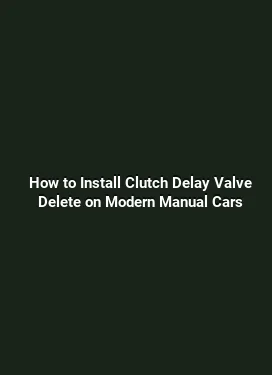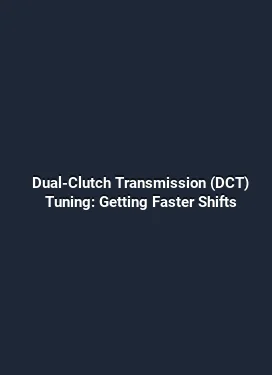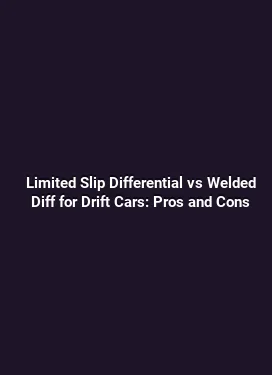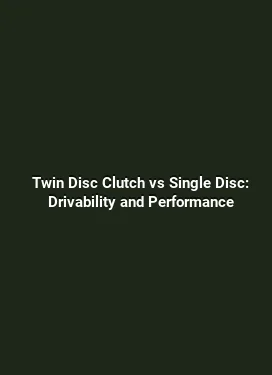Clutch Delay Valve Removal: Is It Worth the Transmission Effort?
The clutch delay valve (CDV) is a small component nestled within hydraulic clutch systems that has a surprisingly large impact on how a vehicle responds when a driver engages or releases the clutch. While many enthusiasts debate its effect on shift speed, pedal feel, and overall drivability, understanding the CDV’s function, potential benefits of removal, and the associated risks is essential before making any modifications. This article examines the CDV in depth, offering practical guidance, safety considerations, and real-world scenarios to help readers determine whether removing the valve aligns with their driving goals and maintenance approach.
What is a Clutch Delay Valve and How Does It Work?

A Clutch Delay Valve is a small hydraulic component integrated into the clutch hydraulic circuit, typically positioned near the master or slave cylinder or along the line feeding the clutch slave. Its basic job is to slow down the initial movement of hydraulic fluid when you press the pedal and, conversely, alter the fluid dynamics during clutch release. The result is a smoother, more “forgiving” engagement that can reduce abruptness during gear changes in certain driving conditions.
From a functional perspective, the CDV introduces a deliberate delay in hydraulic response. In everyday driving, this can translate to a gentler clutch engagement at low RPMs and in stop-and-go traffic, where unpredictable take-up can sometimes cause jerky movements. However, for performance-oriented driving, this same delay may hinder ultra-fast shifts or precise modulation, especially in heavy vehicles or high-trottle applications where quick clutch response is desired.
In terms of autocoefficient behavior, the valve’s presence can slightly soften pedal travel and reduce peak hydraulic pressure during initial engagement. This translates to a more progressive clutch engagement and can be helpful for new drivers or vehicles with a particularly aggressive spring/cable setup. It’s worth noting that the CDV is not a bypass for skill; its influence is subtle and highly dependent on the specific hydraulic architecture of the transmission, pedal ratio, and hydraulic fluid characteristics.
Benefits and Drawbacks of CDV Removal
Removing the CDV is often pitched as a way to achieve more immediate clutch engagement, faster pedal feedback, or a crisper shift in some setups. However, the impact is context-dependent and can vary widely between vehicles and operating conditions. Below are practical considerations drawn from real-world experiences and common installation environments.
Benefits commonly cited by enthusiasts include improved pedal feel for some drivers, slightly faster take-up in certain RPM ranges, and a perception of quicker gear engagement. In performance-oriented builds, this can translate to more direct response, especially on vehicles with less compliant hydraulic lines or upgraded clutches. On the flip side, removal can also increase driveline shocks and introduce harsher engagement, particularly at low speeds or with heavy loads, where the original design helped smooth out momentary fluctuations.
Potential drawbacks extend beyond pedal feel. Removing the valve can alter the hydraulic balance of the system, potentially increasing wear on seals and pistons if the system is not properly tuned. It may also influence clutch slip thresholds, engagement consistency across temperature ranges, and long-term reliability in variants with strict warranty constraints. For vehicles under manufacturer warranty, altering hydraulic components can also affect coverage, so evaluating this risk is essential before proceeding.
Another key factor is compatibility. Not all CDVs respond the same way to removal. Some vehicles may rely on the valve’s hydraulic cushioning to protect the transmission from abrupt shifts during engine braking or to manage shift timing under varying ambient temperatures. In some cases, the absence of the valve can reveal or exaggerate transient hydraulic spikes, causing nuisance noises or odd engagement behavior rather than a clean, linear response. Thorough testing with varying operating conditions is crucial to determine net benefit or detriment.
Removal Process: Step-by-Step Guide and Practical Tips
If the decision is made to proceed, a careful, methodical approach is essential. The removal process involves accessing the CDV, isolating hydraulic lines, and ensuring the system remains free of air before returning to service. Below is a structured guide that emphasizes safety, accuracy, and minimal system disruption.
Step 1: Gather the right tools and materials. Typical tools include a set of metric wrenches, line wrenches to minimize bolt rounding, appropriate seals or replacement O-rings, a clear line or zip-tie method to observe leaks, fresh brake/clutch fluid compatible with the vehicle, and a catch container for old fluid. It’s wise to have a torque wrench handy to re-tighten fittings to manufacturer-specified values. A basic diagnostic scanner or code reader is optional but helpful to confirm no fault codes arise after the modification.
Step 2: Prepare the workspace. Engage the parking brake, disconnect the battery to avoid accidental activation of electrical systems, and ensure the vehicle is on a level surface with wheel chocks. If working in a garage, place the car on jack stands or a ramp, ensuring adequate clearance for the slave cylinder and the master cylinder region where the CDV typically resides.
Step 3: Locate the CDV. In most vehicles, the CDV is integrated into or adjacent to the hydraulic lines between the clutch master cylinder and the slave cylinder. Identify the valve’s body and confirm its orientation using service manuals or clear diagnostic guides specific to the model. It’s essential to avoid disturbing nearby lines, electrical connectors, or sensor housings during removal.
Step 4: Depressurize and drain hydraulic fluid. With the engine off, carefully relieve hydraulic pressure by pressing the clutch pedal slowly a few times to expel residual pressure. Place the catch container beneath the line junctions to capture any fluid that escapes when disconnecting fittings. Use a line wrench to prevent stripping fittings and loosen the CDV connections according to the vehicle’s layout.
Step 5: Remove and bypass or replace the valve. Depending on the design, you may simply remove the valve and install a short, properly rated bypass plug or replace the hose with a sealed line that preserves the integrity of the hydraulic path. Ensure all seals and O-rings are seated correctly to prevent leaks. If a bypass is used, verify it does not create a dead-end or backflow issue in the system.
Step 6: Refill and bleed the system. Once the CDV is removed or bypassed, refill the reservoir with the proper fluid specification. Bleed the clutch hydraulic system to remove any air that may have entered during the process. A proper bleed procedure is crucial to ensure consistent clutch pedal feel and reliable take-up. Use a systematic approach—start at the slave cylinder, then proceed to the master cylinder, and finally verify the fluid level in the reservoir after capping the system.
Step 7: Test and verify. Before a road test, verify there are no leaks, and the pedal returns to its resting position smoothly. Start the engine and perform a controlled in-garage test: engage gears at low RPM, observe pedal response, and confirm there is no abnormal noise or vibration. If any issue arises, re-check fittings or consider reinstalling the original CDV configuration and seeking professional assistance.
Step 8: Document changes and monitor. Keep a detailed log of the modification date, parts used, and any observed effects on shift quality. Monitor the vehicle across varying temperatures and driving conditions to confirm that the modification yields the intended results without introducing new issues.
Preparation, Safety, and Model-Specific Considerations

Preparation begins with a model-specific assessment. Some vehicles employ more complex hydraulic networks with integrated control modules that may react unpredictably to bypasses or valve removals. A thorough review of service manuals, manufacturer forums, and credible technical resources specific to the car model can prevent missteps. Safety involves eye protection, gloves, and ensuring no pressurized fluid is released inadvertently. Because hydraulic systems can retain pressure, always approach with caution and best-practice fluid handling procedures.
For models with sensitive warranty terms or sophisticated drivetrains, consulting a qualified technician is highly recommended. In certain performance-oriented builds, specialists can offer calibrated bypass options or alternate components designed to preserve system safety while achieving the desired driver feel. The goal is to achieve a stable and reliable hydraulic response that aligns with driving goals without compromising longevity or safety.
Risks, Reliability, and Long-Term Implications
Modifying or removing the CDV is not without risk. The most immediate concerns involve the potential for hydraulic system imbalance, increased wear on seals, harsher clutch engagement, and the possibility of unintended shift behavior at certain engine loads. Reliability can be impacted if the system is not properly bled or if bypass components are not correctly installed. In addition, some vehicles rely on the CDV for anti-torque or anti-shock behavior that helps protect the transmission during abrupt throttle changes. Bypassing or removing the valve can alter these protective dynamics, which may lead to unanticipated fatigue on transmission components over time.
Another facet to consider is temperature sensitivity. Clutch hydraulic systems behave differently as temperatures rise and fall. A valve designed to dampen hydraulic surge can complement cold-start behavior and prevent stiff pedal feel, while removal might magnify cold-stiff response or create inconsistent engagement during temperature transitions. The end result is often a trade-off: crisper feel in one condition at the expense of smoothness in another. For daily drivers, such trade-offs can be more noticeable than for dedicated track cars where drivers accept a higher degree of system roughness in exchange for rapid response.
From a maintenance standpoint, removal may necessitate ongoing checks for leaks, hose integrity, and line wear. With the hydraulic circuit altered, the likelihood of developing micro-leaks increases if fittings were not torqued to spec or if the bypass elements introduce minor restriction changes. Periodic inspection becomes a practical discipline to ensure the system remains leak-free and predictable across miles and seasons.
Alternatives and Safer Approaches to Achieve Desired Feel
For drivers seeking a more direct or responsive clutch without fully removing the CDV, several safer approaches can deliver meaningful improvements while preserving system integrity. These options emphasize reliability, compatibility, and consistent performance across conditions.
Option 1: Calibrated hydraulic fluid and line optimization. In some cases, using a fluid with thermally stable properties or relocating/adjusting line routing can improve pedal feel without bypassing essential damping. This approach preserves the hydraulic balance while addressing temperature-related stiffness or delayed response.
Option 2: Upgraded friction materials and clutch components. A clutch with a more linear engagement profile, along with properly matched pressure plate and flywheel values, can produce a more predictable take-up without redefining the hydraulic dynamics. Improvements here can yield a crisper shift feel while maintaining smooth engagement under load.
Option 3: Short-throw or modified pedal assemblies. If pedal feel is the primary goal, a carefully designed short-throw pedal kit paired with an appropriate master cylinder ratio can provide a more direct input-to-response relationship. The overall system remains balanced with the original valve in place, reducing the risk of unintended mechanical stress.
Option 4: Professional re-tuning and diagnostics. Some performance shops offer diagnostic assessments that optimize shift timing, clutch engagement curves, and hydraulic response within manufacturer-safe limits. This can deliver a refined driving experience without compromising long-term durability.
Maintenance, Diagnostics, and Real-World Driving Implications
Understanding how changes affect daily usage is essential for drivers who rely on their vehicles for commuting, towing, or spirited driving. After any hydraulic modification, monitor for changes in pedal travel, fluid levels, and any unusual noises during engagement or disengagement. A systematic approach to maintenance—regular fluid changes, leak checks, and transmission health monitoring—helps ensure the vehicle remains reliable and predictable across miles and seasons.
In real-world driving, the impact of CDV modification often becomes a subtle but noticeable shift in pedal feel and engagement timing. While some drivers report improved immediacy and a more connected sense of control, others experience less forgiving engagement and occasional harshness at low speeds or with heavy loads. The key to a successful outcome is aligning the modification with driving goals, vehicle specifications, and a disciplined maintenance plan rather than pursuing a universal upgrade promise.
Practical Scenarios: When CDV Removal May or May Not Be Appropriate
In a sportier daily driver with a naturally smooth clutch engagement, removing or bypassing the CDV can yield a more direct feel. However, in a vehicle used for frequent stop-and-go traffic, the additional pedal stiffness or heightened engagement at slow speeds may become tiresome. For trucks or vehicles with heavy payloads, the smoother, damped response from the CDV can reduce driver fatigue and gear grinding during climbs or heavy towing. In these cases, removal is less likely to provide a meaningful, consistent advantage and could introduce unnecessary complexity or risk.
Ultimately, the decision is driven by how the vehicle’s current hydraulic system interacts with your driving style, the type of clutch setup installed, and how much risk you are willing to assume in exchange for a perceived performance gain. A cautious, measured approach—test, document, and only proceed with expert guidance—tends to yield the most reliable, user-satisfying outcomes without compromising durability.
Key Takeaways for Transmission and Drivetrain Enthusiasts
For enthusiasts navigating CDV considerations, the most practical path combines knowledge, methodical testing, and a focus on long-term reliability. The valve’s role as a dampener and flow regulator means that removal is not a guaranteed performance upgrade in every scenario. Before making alterations, compare the expected gains against potential risks, warranty considerations, and serviceability. With a disciplined approach, drivers can tailor their transmission and drivetrain experience to their preferences while maintaining robust, predictable operation across a range of driving conditions.
As with any modification that touches hydraulic pathways, the emphasis should be on informed decision-making, careful execution, and ongoing verification. A well-documented, model-specific plan that includes fluid compatibility, bleed procedures, and post-modification testing often yields the most reliable path to the driving experience you seek without compromising durability or warranty protections.
Next Steps and Expert Advice
For readers considering this modification, assembling a careful plan with model-specific guidance is indispensable. Gather reliable service documentation, consult with qualified technicians who have hands-on experience with your vehicle’s transmission family, and maintain a conservative attitude toward changes that alter hydraulic dynamics. The goal is a trustworthy, repeatable driving experience that aligns with both personal preferences and the vehicle’s design intent.
In the end, whether to remove the clutch delay valve hinges on a balance between desired immediacy of response, ride comfort, reliability, and warranty considerations. By approaching this modification with a clear framework and a willingness to validate outcomes through controlled testing, drivers can make an informed decision that respects the integrity of the transmission and enhances the driving experience in a meaningful, measurable way.






